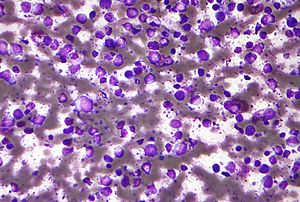
Diffuse large B-cell lymphoma

Diffuse large B-cell lymphoma is a cancer of B cells, a type of white blood cell responsible for producing antibodies. It is the most common type of non-Hodgkin lymphoma among adults, with an annual incidence of 7–8 cases per 100,000 people per year in the USA and the UK. This cancer occurs primarily in older individuals, with a median age of diagnosis at approximately 70 years of age, though it can also occur in children and young adults in rare cases. DLBCL is an aggressive tumor which can arise in virtually any part of the body, and the first sign of this illness is typically the observation of a rapidly growing mass, sometimes associated with B symptoms—fever, weight loss, and night sweats.aggressive: Sézary disease Diffuse large B-cell lymphoma is a cancer of B cells, a type of white blood cell responsible for producing antibodies. It is the most common type of non-Hodgkin lymphoma among adults, with an annual incidence of 7–8 cases per 100,000 people per year in the USA and the UK. This cancer occurs primarily in older individuals, with a median age of diagnosis at approximately 70 years of age, though it can also occur in children and young adults in rare cases. DLBCL is an aggressive tumor which can arise in virtually any part of the body, and the first sign of this illness is typically the observation of a rapidly growing mass, sometimes associated with B symptoms—fever, weight loss, and night sweats. The causes of diffuse large B-cell lymphoma are not well understood. Usually DLBCL arises from normal B cells, but it can also represent a malignant transformation of other types of lymphoma or leukemia. An underlying immunodeficiency is a significant risk factor. Infection with Epstein–Barr virus (EBV) has also been found to contribute to the development of some subgroups of DLBCL. Diagnosis of DLBCL is made by removing a portion of the tumor through a biopsy, and then examining this tissue using a microscope. Usually a hematopathologist makes this diagnosis. Several subtypes of DLBCL have been identified, each having a different clinical presentation and prognosis. However, the usual treatment for each of these is chemotherapy, often in combination with an antibody targeted at the tumor cells. Through these treatments, more than half of patients with DLBCL can be cured, and the overall five-year survival rate for older adults is around 58%. The most typical symptom at the time of diagnosis is a mass that is rapidly enlarging and located in a part of the body with multiple lymph nodes.
